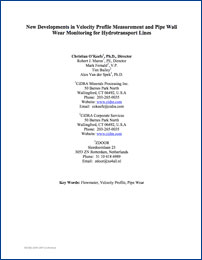2009 CMP • New Developments in Velocity Profile Measurement
New Developments in Velocity Profile Measurement and Pipe Wall Wear Monitoring for Hydrotransport Lines
Sonar array-based non-invasive flow measurement technology is becoming an accepted and many times a preferred method of measuring challenging single and multi-phase flows in the mineral processing industry. This fundamental sensor and measurement technology has been extended to two developments that provide new measurement capabilities useful for monitoring and managing slurry flows and pipes.
The first development is the non-invasive measurement of real-time velocity profile of slurry flow in horizontal pipes. Multiple non-invasive passive sensors measure localized velocities and are combined to provide a velocity profile measurement. This information can be used to determine the approach and onset of solid deposition on the bottom of the pipe. Having this information in real time can enable operation at lower velocities and/or higher solids concentration while avoiding solids deposition or plugging and its associated operational costs.
The second development is the non-invasive measurement of pipe wear on slurry lines. Presently, such measurements are made by hand-held portable ultrasonic thickness gages. The numerous shortfalls associated with the manual method are overcome with a set of permanently or semi-permanently installed transducers clamped onto the outside of the pipe. This ring of sensors contains a series of conformable ultrasonic transducers spaced around the circumference, which are used to measure the thickness of the pipe under their respective locations. Compared to manual methods, this system and approach results in better repeatability and accuracy. It also decreases inspection labor costs and pipe access requirements. The minimal accuracy variations in the presence of varying environmental temperatures will be shown. Trending of pipe wall thicknesses in high wear pipelines will be illustrated. The benefits of significantly improved pipe wear monitoring in hydrotransport lines with abrasive solids, and associated improvement in the ability to insure safe operation and avoidance of costly environmental damage due to leaks caused by pipe wear will be discussed.

